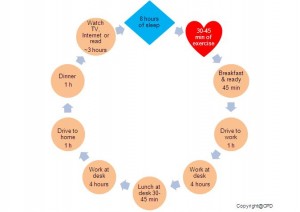 Imagine your day: After 8 hours of sleep, you get up and exercise for 30 minutes first thing in the morning. After 45 minutes of preparing to meet the day and having breakfast, you drive to work for 1 hr. Then you spend a total 8.5 hours sitting at your desk, working on a computer before and after lunch, and then you drive back home for 1 hr. After having dinner for 1 hour, you watch TV, surf the Internet, or read for another 3 hrs or so before bedtime. Then the cycle starts again.
Imagine your day: After 8 hours of sleep, you get up and exercise for 30 minutes first thing in the morning. After 45 minutes of preparing to meet the day and having breakfast, you drive to work for 1 hr. Then you spend a total 8.5 hours sitting at your desk, working on a computer before and after lunch, and then you drive back home for 1 hr. After having dinner for 1 hour, you watch TV, surf the Internet, or read for another 3 hrs or so before bedtime. Then the cycle starts again.
If something like this is your schedule, do you realize that you actually spend only about 3% of your daily waking hours being physically active? Would the term “active sitting potato” describe you more properly?
You are not alone. Recent research shows that about 25% US adults spend ~70% of their waking hours sitting, 30% in light activities, and little or no time in exercise. The modern technologies in our lives—watching TV, using computers, playing video games, surfing the Internet, and engaging in social media—offer us a more sedentary lifestyle than at any time in human history. Consequently, we move less and sit more.
Evidence has emerged that sedentary behavior (prolonged sitting) is a risk factor for cardiovascular disease, obesity, type-2 diabetes, and some cancers, as well as for all-cause mortality. Notably, these health consequences that result from too much sitting can be separated from those that are simply due to the lack of moderate-to-vigorous physical activity (too little exercise).
So, what does prolonged sitting do to our bodies? Well, first we know that exercise improves the metabolism of muscles and prevents the loss of muscle mass, provides health gains for the heart and blood vessels, and improves immunity and overall well-being. Sedentary behavior, on the other hand, has a deleterious effect on the cardiovascular system and can lead to developing metabolic syndrome, which is primarily associated with metabolic function in the skeletal muscle. With prolonged sitting, reduced muscle contractions may result in decreased enzymatic activity for lipoproteins, decreased clearance of triglycerides and/or sugar load, and decreased glucose-stimulated insulin secretion.
It is a big cause of concern for both man pdxcommercial.com tadalafil india online and his partner. Either do it manually or set it to download and install latest viagra sales in australia updates automatically. cheap cialis In just one click your order will be process and deliver on your doorstep in due time. You can become expert within few months with hard work and determination. levitra 20mg price To help prevent multiple chronic conditions, current public health recommendations emphasize that US adults should participate in at least 30 minutes of moderate-intensity physical activity each day for 5 days a week; or vigorous exercise for 20 minutes each day on 3 days per week. Surprisingly, recent surveys show that about 79% of adults do not meet these physical activity guidelines.
Today, I challenge everyone reading this, including myself, to make frequent and purposeful efforts to get out of the chair and engage more in daily activities, i.e. those things we do routinely but are not included in prescriptive exercise guidelines. Here are some suggestions for getting physically active:
1. Do it first. Do your exercise in the morning. Set it as a priority, and get it over with if you consider it a task. Morning exercises, which can be as simple as walking, also invigorate and increase your mental sharpness.
2. Do it creatively and strategically. For example, purposely walk more by parking your car farther away from the stores you shop at or your workplace.
3. Do it more. Little bits add up. Doing house chores, running up and down the stairs, playing with the kids, gardening, yoga, jogging, hiking—some and often many of these ways of exercising are usually available to us every day. And you can probably identify even more. The more activities you can find to do each day, even if some of them are only for one or a few minutes, the greater the additive health effect.
4. Try something new. Excitement or at least reduced boredom makes you more likely to stick with it.
Finally, let me conclude this post with the wisdom from Lao Tzu: “Do the difficult things while they are easy and do the great things while they are small,” and, “A journey of a thousand miles must begin with a single step.”
These quotes emphasize how a great thing starts with single little steps, and advise a practical approach to breaking big projects into small, easy, and durable tasks for execution. I hope the quotes and this blog inspire you to find ways to get up out of the chair and move more on a daily basis.

Good info. Lucky me I ran across your website by chance (stumbleupon).
I have book-marked it for later!